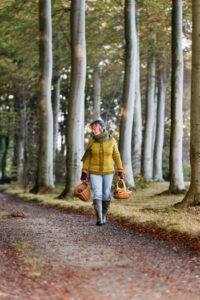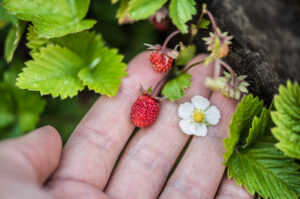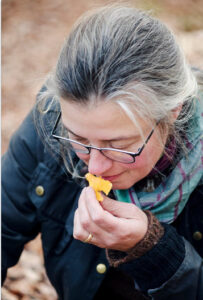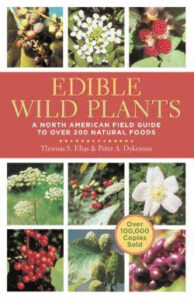Supplies may not always be available in a survival situation, whether it’s a short or long-term event. You might see stores shutting down, supply chains getting interrupted – or you may have to bug out at a moment’s notice and not have anything with you when it happens.
You never want to be without food and water. One of the skills that can help you safely get through a situation like this is learning how to properly forage for food. You can do this anywhere at any time, but you have to do it carefully because you don’t want to get sick from not knowing what to gather and eat versus what to avoid and leave alone.
You want to know how to identify resources that will provide you with the nutrients and calories you need to get through each day. It’s very important to understand how to differentiate between plants that look very similar because one may be poisonous while the other is safe for your family to consume.
Your Guidelines for Foraging Properly
The first thing you want to do is understand the proper guidelines for foraging food. The things you are going to need to learn include recognizing which plants will be good for you to eat, and understanding how to find and harvest them in the wild.
There are some plants that you will be able to find in suburban areas, right under your nose, while others may be out further in the woods or near a lake. It all depends on where you live and how far you’re willing to go to find the sustenance that you need.
There is no one-size-fits-all approach to foraging. This is a skill that is going to depend fully on where you live, because your access to a variety of plants is going to be different from everyone else’s.
Ideally, you’re going to have a number of options to choose from, so you may be able to pinpoint a certain plant that grows in abundance in your area. You can start with that and figure out the caloric count and nutrients that it will provide.
This is perfect to do in the very beginning and slowly add more and more foods to your knowledge as you start to master the foraging process. You want to take precautions in learning how to tell plants apart.
For example, you might think you’re foraging wild carrot, but you’re actually gathering poison Hemlock. Knowing small differences, such as the smooth stem of the Hemlock versus a hairy stem on wild carrot – can save your life.
Sometimes, you can’t even touch certain plants safely, so you may want to be wearing gloves initially as you learn the ropes. When foraging, one guideline you need to follow is to take what you need or what you can store and don’t strip the land of everything if you’re going to let it go to waste.
You’re not the only living beings foraging for food outdoors, and the wildlife needs to have plants to eat as well. If you’re learning the skill and you’re not in a survival situation, you may also have to abide by certain local guidelines.
Some areas are protected from foraging, or have certain seasons when you’re not allowed to forage. Other laws may pertain to the quantity of what you can gather, and you don’t want to get in trouble as you learn. For example – certain mushrooms are only in season at specific times and there are limitations how much you are allowed to take . Of course – in a survival situation you will be able to ignore this, no one is going to come after you. Mind you – mushrooms do taste nice but their nutritional value isn’t the greatest and there is always the potential to get it wrong and pick poisonous ones.
You Should be Starting Off with a Beginner Foraging Plan
To get started, once you know the proper guidelines you need to be following, you’re going to want to begin learning what you can forage in your area, but you have to have tools to forage with.
Many people think they’ll simply walk out into the woods and yank plants out of the ground or pick things off of plants. But you don’t want to damage your food sources. You’ll want to have a sharp knife or gardening scissors as one of your tools.
We’ve already mentioned gloves as an important tool, but you also need something to put your harvested items in. You can use a cloth bag or different type of container – from a plastic one to a wooden basket.
You may want to have different containers on hand – such as one for leafy green plants and another for berries or one for nuts that you find. You don’t want to pack too much into one container because if you’re foraging for things like berries, they’ll become mushed and ruined.
Another thing you’ll definitely want to have on hand, even if you have begun researching this ahead of time, is a good reference guide that is applicable to your geographic location about what you can and should not forage.
Although there are mobile apps that you can use to identify plants, you don’t want to learn how to do that for survival purposes, but instead use it as a backup while you are initially learning. Always have a print handbook to go by in the event that you’re not able to access the Internet because the grid is down or power is indefinitely lost.
When you are selecting a guide to help you learn how to forage, choose those that give you as much detail as possible about the plants, including pictures that you can use to properly identify whether or not something is edible.
In many large cities, you’ll be able to find local guides that you can hire to take you out on an outing and show you exactly what is edible and how to harvest it. Having this hands-on education is a great supplement to your printed materials.
It’s a good idea to bring everyone in your family along when you are learning how to forage so that they don’t make any mistakes in the future about what is safe to eat. Start by showing them plants they can consume that will not put them at risk of misidentifying it and mixing it up with something poisonous.
For example, dandelions are an average weed that most people try to get rid of, but they’re actually edible. You can also teach them to harvest clover and chicory if you can find that in your area.
Learning how to forage is not just about knowing which plants to harvest. It’s also about being able to recognize where these plants will be found, which parts of them are edible, and the proper way to harvest them.
You might find a particular plant that grows in abundance, but you can only use one portion of it for nutritional purposes. You also want to keep track of in which season or months these particular plants are most likely to appear and be ready for harvesting.
Know How to Store and Prepare Your Foraged Supplies

These will include things like the dandelions or berries and some nuts. As soon as you wash them, you can eat them raw or you can cook things to consume, too. Some items that you harvest will be better if you can flavor them up with some seasoning and cook them.
For example, if you pick some roots or leafy greens, you’ll want to sauté those, boil them or even put them on the grill. You’ll want to store them, along with herbs and mushrooms, in a cool and dark location.
With some foods that you harvest from the wild, the cooking process is what can make them no longer toxic, so you have to understand what to cook, when and for how long. An example of this is the Fiddlehead Fern, which is toxic if you don’t cook it the right amount – boiling it for 10-15 minutes.
Make sure you also have a plan for long-term storage, using a canning or drying strategy. You can preserve some of the foods for later use, such as putting up fruit you can use as jam or in pies – or pickling items for later consumption.
So now that you know about preparing and learning about foraging for survival situations it is time to move on to the next chapter in our Survival Prepping 101 series. Check out Survival Prepping 101 Series Part 26: You Should be Planning for Sanitation and Hygiene Issues.
If you missed the last installment in our series you can check it out here: Part 24 – Know How To Survive in Urban Situations


